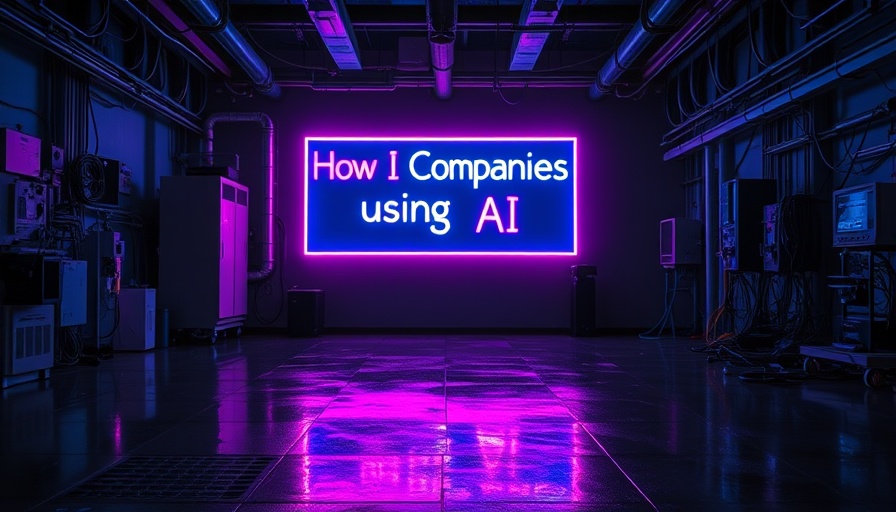
Understanding How AI Companies are Leveraging AI
In the rapidly evolving landscape of technology, the utilization of AI has transitioned far beyond mere experimentation. A recent report from the investment firm Iconic sheds light on how AI companies are not just creators of AI technology but are actively integrating these advancements into their business practices. This shift signifies a maturation of the industry, where firms are increasingly focused on practical applications and scalable solutions in their operations.
In 'How AI Companies Are Using AI,' the discussion dives into the practical application of artificial intelligence within businesses, exploring key insights that sparked deeper analysis on our end.
The Spectrum of AI Integration in Companies
According to the survey of 300 AI companies, respondents can be categorized into three main groups. About 31% consist of AI-enabled companies, like Atlassian, which implement AI capabilities into existing products. The next group, making up approximately 37%, are those that develop new AI products, such as Salesforce, which prioritize AI while not relying solely on it for their core offerings. Finally, 32% are AI-native firms, like 11 Labs, embracing AI as their central product.
These categories are telling; AI-native companies are generally ahead in AI product development, with only a small percentage remaining in beta testing compared to a larger portion of AI-enabled companies. This difference emphasizes the importance of having dedicated resources and vision regarding the application of AI technologies.
Key Metrics and Insights on AI Deployment
The findings underline a significant trend: as organizations evolve into more advanced AI integration, the importance of dedicated leadership for AI efforts becomes clear. For firms reaching a scale of $100 million, AI leadership roles are increasingly common, indicating that size encourages more strategic deployment of AI resources. Notably, 46% of organizations report they are not hiring fast enough for AI-specific positions, highlighting the fierce competition for talent in AI fields.
Cost considerations play an essential role in these organizations' decisions—shifting from the experimental phase, where functionality overshadowed cost, to active deployments where budget constraints become paramount. A substantial 70% of respondents expressed that managing API usage fees is a significant challenge, prompting exploration into open-source models for potential cost savings.
Challenges of AI Adoption and Use Cases
While excitement surrounds AI's possibilities, companies are grappling with various challenges, with 'hallucinations' (misleading AI outputs), and finding appropriate use cases topping the list. Surprisingly, even AI builders report difficulties in identifying fitting applications for their technologies. This insight is critical: it reflects the need for not only the technology itself but also strategic foresight in its applications for internal and external operations.
Current trends show that productivity enhancement is the primary metric by which organizations gauge the success of their AI investments. A notable 75% of firms prioritize assessing productivity gains, contrasting with the 51% considering cost savings and only 20% focused on revenue uplift. This suggests a prevailing orientation towards efficiency, particularly among younger companies that are still refining their business models.
The Road Ahead: Financial and Operational Trends
As AI adoption accelerates, budgets allocated for internal productivity-focused AI are projected to nearly double by 2025. Organizations will be spending between 1% and 8% of total revenue on these initiatives. Remarkably, the majority of funding is now drawn from existing R&D efforts rather than separate innovation budgets. This shift signifies an essential transition from exploratory phases to practical integration, where existing workflows and resources are optimized for AI deployments.
Moreover, organizations that embrace AI fully tend to discover more use cases, with those employing AI tools seeing an average of 7.1 different applications. Uses range from coding assistance to sales productivity, with many companies reaping significant productivity benefits from tools like AI-powered coding assistants—demonstrating a tangible return on investment.
Final Thoughts: Embrace AI Now
As the landscape continues to evolve, it’s crucial for businesses to understand not only the capabilities of AI but also how other companies are leveraging this technology effectively. The ongoing developments in AI are both exciting and imperative to monitor as they impact operational efficiency and future growth. To stay competitive, companies should start using AI now to explore its vast potential in enhancing productivity and streamlining processes.
 Add Row
Add Row  Add
Add 




Write A Comment